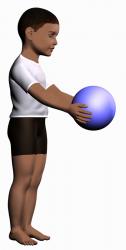A teaching session based on task based training principlesJason, aged 8, complains that he is not good at catching balls. He get frustrated because the boys at school do not allow him to join in their games at recess. His confidence in his ball catching abilities is so poor that he initially refuses to engage in a ball catching activity with me.
The reason for this automatic defensive response is that he has not learned to watch me as I throw the ball and use this information to predict the flight path of the ball. (Remember that one of the core deficits in autism is the ability to predict what happens next.) No wonder he has no confidence in his ball catching abilities. My first job as his therapist/trainer is to help him develop his ability to predict the path of a moving ball, and at the same time build his confidence by providing many opportunities for him to succeed. So we start with a ball rolling game. We create a goal using two boxes and Jason stands facing the goal about 2 meters away. I roll the ball to Jason so that he has to take a small step sideways to intercept the ball. Then he scores a try by rolling the ball into the goal. To be quite sure that Jason pays attention to my actions and the path of the ball, I cue him: Are you watching me? Here comes the ball? He catches the ball successfully each time I roll it to him. He takes great pleasure in this game and as a result of his repeated success, he is willing to play a catching game with me.
Jason manages to catch the ball 6 out of 10 times. He is so pleased with his success that he insists we keep on playing for another 20 tries. |
How has Jason benefited from this training session?
Read more: Task based training for children with autism |
Motor learning and control in autism
Jason learns to catch a ball: a teaching session
How children with autism and DCD learn new motor skills
Children with DCD need help learning new skills
Task based training for autism and DCD
Walking without bumping and tripping
How to motivate a reluctant child
How to help your child - Make time for training
The 15-minutes a day challenge
Where do I start? Selecting and setting goals
For therapists
Why take a task based approach to physical therapy?
A video tutorial
|
Joan, mother of 8 year old autistic Zak and SfA Fitness and coordination Training Guide Your website is the only site I have found that has answered all my questions and provided practical solutions for my son's challenges with posture, muscle strength, hand writing and muscle tone. I am really looking forward to starting the handwriting work with him as I have known for ages that it was linked to muscular strength/flexibility problem but did not have the tools to work on it. Previous occupational therapy made differences in other areas but not that one. Now I can test him and have the tools to help him. Brilliant. More about the SfA Fitness and Coordination Training Guide |
 I get him to at least try a few times. Each time I throw the ball to him he turns his head and ducks slightly to the side as if he expects the ball to hit him in the face.
I get him to at least try a few times. Each time I throw the ball to him he turns his head and ducks slightly to the side as if he expects the ball to hit him in the face.  Jason stands facing me with the hands placed ready to catch the ball at waist height. I throw the ball from a short distance away so that he can easily catch the ball. To do this he has to watch the ball and close his hands on the ball at the right moment. This involves anticipation and planning his action to coincide with the movement of the ball.
Jason stands facing me with the hands placed ready to catch the ball at waist height. I throw the ball from a short distance away so that he can easily catch the ball. To do this he has to watch the ball and close his hands on the ball at the right moment. This involves anticipation and planning his action to coincide with the movement of the ball. 
